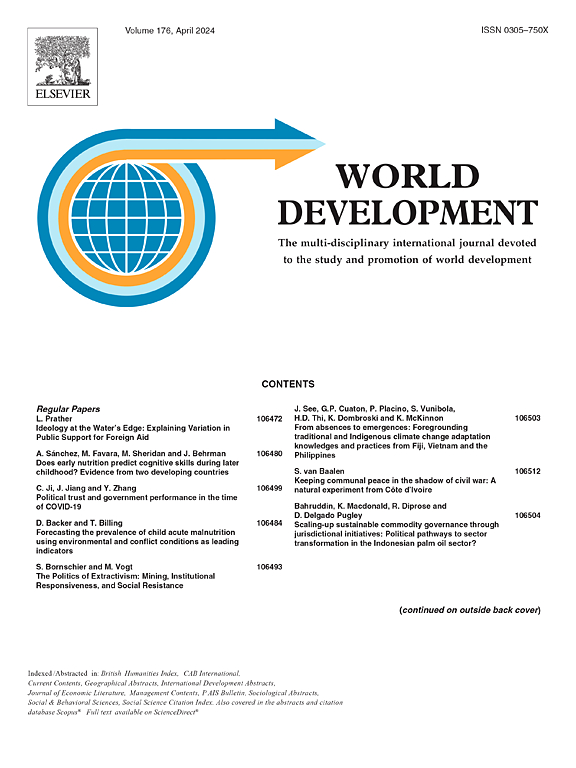中国天然林保护项目在不同林地产权制度下差异影响的不连续回归评估
IF 4.8
1区 经济学
Q1 DEVELOPMENT STUDIES
引用次数: 0
摘要
2000年,中国启动了天然林保护工程,作为森林保护和恢复的旗舰项目,既针对国有林业企业管理的国有林地,也针对农村家庭拥有的大面积林地。本研究评估了国家森林保护计划对森林覆盖的总体影响,并使用空间回归不连续设计检验了该计划在产权制度和省份之间的异质效应。我们的分析表明,NFPP边界内的森林覆盖率平均比邻近地区高6%左右。值得注意的是,尽管集体林地获得的直接财政支持较少,但集体林地的治理效果比国有林地高82%,这突出了制度和地方治理因素的作用。此外,我们的研究结果强调了项目结果的显著地区差异。总体而言,NFPP体现了在经济快速发展的背景下积极扭转毁林趋势的方法,我们的研究结果为完善政策措施和确保在不同森林管理制度中公平的融资战略提供了宝贵的见解。本文章由计算机程序翻译,如有差异,请以英文原文为准。
A regression discontinuity assessment of the differential impacts of China’s natural forest protection program across forestland property right regimes
In 2000 China launched the Natural Forest Protection Program (NFPP) as its flagship initiative for forest conservation and restoration, targeting both state-owned forestland managed by state-owned forest enterprises (SOFEs) and large areas of forestland held by village households. This study evaluates the overall impact of the NFPP on forest cover and examines the program’s heterogeneous effects across property right regimes and provinces using a spatial regression discontinuity design. Our analysis reveals that forest cover within NFPP boundaries is, on average, about 6 % higher than in adjacent areas. Notably, collective forestland experiences an 82 % greater treatment effect compared to state-owned forests – even though collective areas receive less direct financial support – underscoring the role of institutional and local governance factors. Furthermore, our findings highlight significant regional variations in program outcomes. Overall, the NFPP exemplifies a proactive approach to reversing deforestation amidst rapid economic development, and our results offer valuable insights for refining policy measures and ensuring equitable funding strategies across diverse forest management regimes.
求助全文
通过发布文献求助,成功后即可免费获取论文全文。
去求助
来源期刊

World Development
Multiple-
CiteScore
12.70
自引率
5.80%
发文量
320
期刊介绍:
World Development is a multi-disciplinary monthly journal of development studies. It seeks to explore ways of improving standards of living, and the human condition generally, by examining potential solutions to problems such as: poverty, unemployment, malnutrition, disease, lack of shelter, environmental degradation, inadequate scientific and technological resources, trade and payments imbalances, international debt, gender and ethnic discrimination, militarism and civil conflict, and lack of popular participation in economic and political life. Contributions offer constructive ideas and analysis, and highlight the lessons to be learned from the experiences of different nations, societies, and economies.
 求助内容:
求助内容: 应助结果提醒方式:
应助结果提醒方式:


